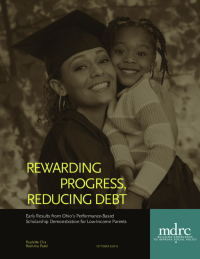Rewarding Progress, Reducing Debt
Early Results from the Performance-Based Scholarship Demonstration in Ohio
Performance-based scholarships are a new and innovative type of financial aid for postsecondary education. The scholarships are performance-based in that the payments are contingent upon meeting academic benchmarks after students enroll in the scholarship program, and do not place weight on past grades. This design is intended to give students an incentive to change their behavior with respect to time management and academics, with the goal of improving their educational outcomes. It also serves students who may not have had much past academic success, and gives them a clean slate. Researchers, institutions of higher learning, and policy experts have a growing interest in performance-based scholarships as a tool to promote academic success, particularly for low-income populations.
Through the national Performance-Based Scholarship (PBS) Demonstration, MDRC is testing variations of this intervention to build evidence on its potential to help low-income students. Ohio is one of six states in the demonstration, and is unique in that its program had existed independent of MDRC’s research. Ohio’s history of cultivating political will to finance a performance-based scholarship with public funds makes this variation especially policy-relevant. The program was offered to low-income parents at three community colleges. This population may struggle with many competing priorities, such as child care or work, in addition to college.
The PBS Demonstration uses random assignment, which is the gold standard in program evaluation and the research methodology preferred by the Office of Management and Budget for demonstrating program effectiveness. MDRC assigned about 2,300 students to either a control group that received the colleges’ standard financial aid package, or to a program group that received the same aid in addition to becoming eligible for receipt of the scholarship. The program lasted for one academic year and offered students awards up to $1,800 per academic year for earning a “C” or better in 12 or more credits per term, or up to $900 for meeting that benchmark in 6 to 11 credits per term. Students were paid at the end of each term, contingent on meeting the performance benchmark.
This report covers the full program year for the first cohort of the study, which comprises students who enrolled in the study in the fall 2008 term. The study sample for the fall 2008 cohort includes about 1,300 students, or roughly 60 percent of the total sample. Early analyses show that:
- The program increased the number of credits attempted. Program group students attempted more credits on average than the control group students in the second program term.
- The program increased full-time enrollment. Program group students were 13 percent more likely to enroll full time than control group students in the second program term.
- The program increased the number of credits earned. Program group students earned more credits in both the first and second program terms, and earned an average of two full credits more than control group students over the program year.
- The program reduced educational debt. Loans made up a smaller proportion of total financial aid for program group students than for control group students. On average, program group students were awarded $237 fewer loan dollars.
- The program has not had any impact on persistence to date. The control group students registered in the second program term at a high rate that was difficult to improve upon.







